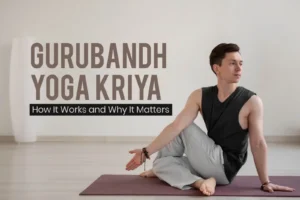Table of Contents
ToggleEvery human once in their life has thought about that they should not say that out of anger. Sometimes it will be really difficult to control your anger but the positive side is anger can be a powerful motivator.But when it is uncontrolled it can ruin things. It can impact lives negatively by damaging our relationships, impacting our physical and mental well-being. So controlling anger is not what we want, we need to manage anger. Anger management is crucial for navigating life’s challenges. Yoga for anger management can be a really helpful tool and it will help to regulate emotion and get inner peace.
This blog will be an exploration of the connection between yoga and anger management and five different yoga poses which can help you in anger management and also discuss the overall benefits of yoga in your life for anger management.
Yoga for Anger Management- How it Helps
Yoga, an ancient practice which combines physical postures, breathing techniques and meditation to promote a holistic approach to well being. It will help you to improve the mind- body connection, allowing us to become more aware of our emotions and reactions and this will help you to manage your emotions and reactions.
- Mindfulness– A core principle of yoga, mindfulness will emphasize present moment awareness which means to live in the present. By focusing on your breath and bodily sensations during yoga poses, you can create a space between your emotions. This space will help you to allow a more measured response to anger triggers, preventing you from reacting impulsively.
- Relaxation and Stress Reduction-Anger often stems from underlying stress and tension. Yoga’s combination of physical postures and breathing exercises promotes relaxation, stress hormones will be decreased and it calms the nervous system. By attaining a calmer body and mind you can handle the anger triggers. .
5 Yoga Poses to Release Anger
1. Easy Seated Pose (Sukhasana)
- Pose: Sit comfortably on a mat or cushion with your legs crossed. If sitting cross-legged is uncomfortable, you can sit in a chair with your feet flat on the floor. Keep your spine erect and shoulders relaxed. Keep your hands on your knees with palms facing down.
- Benefits: Sukhasana improves posture, promotes relaxation, and grounds your energy.
- Anger Management: This simple pose allows you to focus on your breath and become aware of any tension in your body associated with anger. By observing your emotions non-judgmentally, you can begin to de-escalate your anger response.
2. Camel Pose (Ustrasana)
- Pose: Come on to your knees, hip-width apart. Place your hands on the lower back and fingers should be pointing down. Gently arch your back, pushing your hips forward and keeping your gaze upwards. Hold and take a few breaths, then slowly you can return to the starting position.
- Benefits: Ustrasana opens the chest, improves flexibility, and energizes the body.
- Anger Management: This backbend pose helps to release tension in the shoulders and chest, areas where anger often manifests physically. The deep breathing required in this pose further promotes relaxation and emotional regulation.
3. Revolved Crescent Lunge (Parivrtta Anjaneyasana)
- Pose: Start with a high lunge position and right leg should be forward and left leg back. Twist your torso to the right, reaching your right arm up towards the ceiling and your left hand behind your left thigh for support. Look up towards your right hand. Hold and take a few breaths, then repeat doing this on the other side.
- Benefits: Parivrtta Anjaneyasana stretches the hips, improves balance, and detoxifies the body.
- Anger Management: The twisting motion in this pose helps to release tension in the spine, which can hold onto anger and frustration. The focus required to maintain balance promotes present-moment awareness and takes your mind off anger triggers.
4. Goddess Pose (Utkata Konasana) with Ganesha Mudra
- Pose: Stand with your feet wider than hip-width apart and toes turned slightly outward. Squat down, keeping your knees in line with your ankles and your back straight. Bring your hands together in front of your chest, palms facing outwards, with thumbs extended (Ganesha Mudra). Hold for a few breaths.
- Benefits: Utkata Konasana strengthens the legs and core, improves stability, and opens the hips.
- Anger Management: This powerful pose helps to ground your energy and provides a sense of empowerment. The Ganesha Mudra, symbolizing removal of obstacles, can be a mental reminder to let go of anger and embrace inner peace.
5. Corpse Pose (Savasana)
- Pose: Lie flat on your back and your arms should be at your sides and palms facing up. Close your eyes and focus on your breath. Allow your body to completely relax. Stay in this pose for 5-10 minutes.
- Benefits: Savasana reduces stress, promotes deep relaxation, and improves sleep quality.
- Anger Management: This final resting pose allows you to integrate the benefits of your yoga practice and release any remaining tension associated with anger.
By doing yoga and becoming aware of the emotions and triggers you can manage your emotions not only anger. In this blog we have discussed the benefits of yoga and how it can help you manage your anger and not affect your life negatively. Just like yoga for anger management, you can use yoga in your daily life to attain inner peace. To know more about yoga and how it can help you live a life with peace and happiness, you can check out our blogs.



















